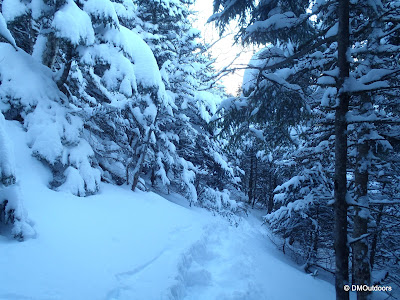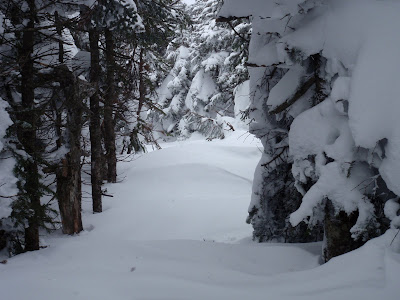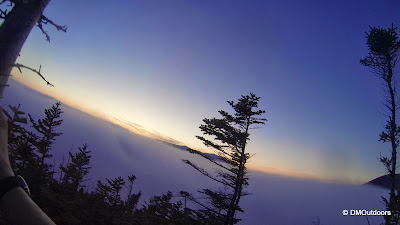One of the very numerous challenges of winter hiking is trail breaking. Trail breaking is required when one is up against a section of trail ahead that is covered completely with snow and no tracks leading the way. This could be a dumping of several inches of either dry or wet snow, or it could be a result of natural accumulation over a section of trail that was previously broken out due to high winds and drifting. Often times this will just fill the tracks. Even if there is a new trace of snow over a previously broken out trail, you are essentially on your own in terms of staying on the trail. Don't count on the blazes always being visible in the winter. Staying on the trail is just the other necessity that comes along with the extra physical exertion required to break trail through whatever depth of snow it may be.
(Cover photo; broke out an entire hike solo to Osceola's, December 2012)
Now, for a couple of my toughest trail breaking moments ever..
Garfield Ridge Trail, January 12, 2013
Last January, I left Lincoln Woods with an open plan for a winter Pemi Loop. By that, I mean I was carrying basic overnight gear with a tarp, but no tent - hoping to do it in about 24 hours, and include as many of the 12 4K's on the extended Pemi Loop as I could. The forecast called for possible freezing rain, and warm daytime temperatures. I had a couple of things fight back at me on this particular hike. The first one was making a wrong turn off Liberty and starting to head in the wrong direction. After losing over an hour with this stupid mistake, I was on my way back in the right direction. Then, at random on the Franconia Ridge Trail after Liberty, the broken out trail simply disappeared in front of me. I found myself getting a little apprehensive here trying to find the trail, especially after I had made multiple circles of my own tracks in the section of drifted trail to make it harder. This was taking place around sunrise. Eventually, I found the corridor hidden beneath a series of weighted-down pine trees crossing the corridor, making it look like a wall of trees. Even though I started at 2:50am, a wrong turn and losing the trail resulted in it taking 8 hours to get from Lincoln Woods to Lafayette, and it was approaching noon.

I could have hiked down Lafayette and hitched back to Lincoln, but I decided to continue on knowing that I would likely call it a night at Garfield Shelter. However, that decision would result in one of my toughest, nastiest trail breaks ever. Every step between Lafayette and the Garfield summit was accompanied by pounds of wet snow on my snowshoes. Accordingly, each and every single step forward felt like I my feet weighed a ton. Never mind that, any and every single snow covered branch that brushed my jacket, resulted in my jacket being pretty much soaked through, along with the t-shirt I was wearing underneath. It was unseasonably warm that day. This slowed my progress significantly, and when I arrived at the Garfield Shelter it had taken me an additional five hours to go about 3 miles. By this time, I had about an hour until light was gone. I had no choice but to make the only choice of quickly getting to Garfield Shelter and getting settled in. Despite the whirlwind of a day, and seemingly having everything not go my way, I met a couple of other hikers who gave me a ride back the next morning to Lincoln after staying in the shelter too. They had come the same way about an hour later, but had the luxury of following my broken out trail. Had they not stayed there, I would have had to make the choice the next morning of continuing or not. While I don't have any pictures from the trail, I do have this Garfield summit photo at sunset below that shows me as as being completely exhausted and soaked.
 |
| Exhausted, soaked, and not that stoked on Mt. Garfield |
 |
| Garfield Shelter |
Blizzard Nemo Before A Planned Presi Traverse, February 2013
Last year, the morning after Blizzard Nemo dumped a dousy on the Northeast, I had myself scheduled to attempt a Solo Presidential Traverse. I arrived at Applachia, to find arguably the most popular trail head still completely un-plowed, including a 4-5 wall of the heavy stuff at the very beginning of the entrance (very common especially just hours after a major storm). This is why all winter hikers know to bring a heavy duty shovel, just in case. Already an hour late from the brutal drive north on rough roads, I was facing a pretty tough decision. As crazy as this sounds, I grabbed my shovel and got to work. I shoveled a driveway in wide enough for the Jeep, along with an extra wide corner, and a perpendicular lane wide enough to pull into the lot in reverse, and park parallel to the row of rocks. Now fully warmed up after about a 45 minute work-out, I was ready to hit the mountain to salvage whatever I could on the hiking day. As I started past the Appalachia trail sign, I found myself in the midst of one of my toughest trail-break ascents ever as I set off for Mt. Madison.
 |
| The view of the Jeep after I reversed into the L-driveway I made. |
 |
| YIKES!!! |
The fresh snow was approximately two feet deep. It's consistency was slightly heavier than powder, but not epic wet snow. This meant that after most steps, the deep snow just covered my snowshoes and ankles, which is a factor that makes trail breaking so strenuous sometimes. The 4 mile ascent of Mt. Madison via Valley Way might have taken me two hours with broken-out trail, but instead it took me five hours. While it was incredibly beautiful, this is not what you want to face unprepared, without snowshoes. That day, I completed Madison, Adams, Jefferson as an out-and-back to Jefferson by Valley Way.
 |
| Valley Way Trail |
 |
| Looking back at my tracks |
Besides those ridiculous events, here are a few more photos of trails that I've broken out and certainly, where you might find yourself trail breaking someday too. Are your snowshoes ready?
 |
| Hancock Loop Trail |
 |
| Mt. Clay, Solo Presidential Traverse |
 |
| Wind blown snow covering tracks as I go on Signal Ridge Trail |
 |
| Carter-Moriah Trail |
 |
| This sign is over my head in the summer - Alpine Zone, Boncliff Trail |
So after re-visiting these two trail-breaking experiences, lets take a look at some brief pointers and some of the things to keep in mind should you be looking ahead at some unbroken trail while hiking in the winter.
Type of Snow
What is the consistency of the snow on the ground? Is it powder? Is it a hard-crusted surface with powder underneath, or is it brutal wet snow? Assuming you've checked the forecast, you can gather some expectations on what conditions you might experience, but by running this question through your head, you can think of what conditions you might be in for. Powder is not so bad, wet is bad, and when there is a layer of hard crust on top of deep snow, it can require a lot of extra effort to bust through it. Then, pay close attention to the the mileage and terrain ahead so you have an idea on how strenuous it might be and for how long before you get yourself in too deep!
Blazes
Pay attention to the blazes. In the White Mountains, the snow gets so deep in some sections, the blazes that may remain visible can come a few and far between. On the Appalachian Trail, they are white, so navigating any part of the AT in the winter can be tricky depending on the depth of snow. Windblown snow can freeze onto tree trunks covering blazes regardless how much is on the ground. If you lose the trail, start by going back to the last visible blaze and cautiously move forward from there. Most importantly, do not panic - its best to take a short break when this happens. This has happened to me on Kinsman Ridge Trail near the Cannonballs and Franconia Ridge Trail between Liberty and Little Haystack.
Leaning Trees
"Leaners", as some might say, are trees that lean over the trail and obstruct the trail corridor, usually from heavy snow. If you lose the trail corridor, I recommend back-tracking to the previous blaze or landmark, just as if you lost track of the blazes. As you attempt to locate the way though, use your trekking poles (not your hands or gear) to knock the snow off, as you do what you can to avoid the snow getting onto your gear. Then, be careful as the leaning trees or branches will either abruptly or slowly bend back to their normal position, at which point may or may not be lucky enough to have the path open up before you.
Gear For Breaking Trail
Snowshoes
While sure, you can
try to "break trail" without snow shoes, but without snowshoes you're not really prepared for winter peak-bagging in New England. As I suggested earlier, the need to break trail can happen anytime after you have begun your hike, so don't make a snowshoe decision just by looking at the start of the trail. Around the time of the holidays is when I recommend having snowshoes as part of every pack list, unless we're talking about a short hike up to Pierce on a nice winter weekend day where the trail is like an easy ramp from bottom to top.
Boots
While there is a whole lot more to getting the proper fitting boots, for trail breaking, make sure they fit with your snowshoes and other footwear equipment, as needed. For trail breaking, you're going to want a warm and waterproof boot. Regardless of the type of snow, your boot may become wet if you have to hike through deep snow for a long period of time. In this scenario, I wouldn't want to find myself with a pair of boots that are old, questionably water-proof, or don't offer enough support to pull a snow shoe.
Gaiters
Along with comfortable, breathable pants for winter hiking (which I won't get into here), full-height gaiters are highly recommended for comfortable trail breaking. Even though some pants are waterproof, doing everything you can to keep your feet, ankles, socks, and footwear dry is important. Especially, if you come across deep wet snow, you will want that extra layer and comfort. Gaiters can also be a hike-saver and life-saver for those times you accidentally dip your foot in a river for a second on a rock-hop crossing. The heavy-duty gaiters such as the tough Outdoor Research Crocodile Gaiters are ideal for tough trail breaking hikes.
Human Power
One thing that I almost forgot about... Extra human power is a good, safe way to make trail breaking a lot easier. Breaking trail solo in the middle of the winter can be a daunting task, so if one is expecting to hike a trail that is not broken out, having multiple people will make it easier for everyone. To use the extra human power as a way to make it easier, take turns being the first in line, and even rotate the line so that everyone gets a chance to be in front where its harder and in back where its easier. Hiking pace is important, so don't overlook that when you position your hiking group for a trail break.
Think About Trail breaking as you plan for your winter 4000-footer hike
Mainly from my experiences and through reading and planning my winter hikes, here are some White Mountain Trails that are either least likely to be broken out after storms or where you may find difficulty finding the trail from frequent drifting:
- Carter-Moriah Trail - between Stony Brook Trail and Mt. Moriah
- Garfield Ridge Trail - Between Skookumchuck Trail and Mt. Garfield
- Kilkenny Ridge Trail - Middle portion, access to Terrace and the Weeks
- Twinway - Between South Twin and Guyot (especially right after a storm)
- Starr King Trail - the ridge between Mt. Starr King and Waumbek has frequent drifting
- Franconia Ridge Trail - I have experienced challenging spots between Flume and Liberty, and Liberty and Little Haystack for both drifting and tough trail breaking.
*If you think there are some trails that I should have listed here that are not, please leave a comment! Trails that are often not broken out or get drifted over easily...
Knowing whether the trail is going to be broken out in advance is a pretty important thing when it comes to winter hiking. Many hikers will plan their hikes strictly for those that are likely to be broken out. For me, I sort of like to let the mountain just throw what's it got at me, but either way you prefer it, you really should always check out the recent trail condition reports anyways by visiting
TrailsNH.com. This site has every single trail condition report in the Northeast, including those submitted at
Newenglandtrailconditions.com, and from just about every popular New England hiking blog. Read the reports, some of which are from very experienced winter hikers, and figure out what equipment was recommended for the day. Conditions change rapidly, and yes, sometimes there are no recent reports for the peak you're headed to, which means that you should plan for some trail breaking. If you get lucky and you're snowshoes take a ride all day, so what, its good to be always be prepared.
I hope that you found this article informative and enjoyed reading some more detail from those trail breaking experiences. Besides all of the caution, you should know that breaking trail can be fun and its a remarkable workout that will make you aware of muscles you never thought you had! Happy Trail-Breaking!






